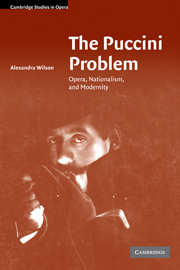Book contents
- Frontmatter
- Contents
- List of illustrations
- Acknowledgements
- Note on translations
- Introduction
- 1 Inventing an Italian composer
- 2 La bohème: organicism, progress and the press
- 3 Tosca: truth and lies
- 4 A frame without a canvas: Madama Butterfly and the superficial
- 5 Torrefranca versus Puccini
- 6 The Italian composer as internationalist
- 7 A suitable ending?
- Epilogue
- Appendix 1: selected newspapers and journals
- Appendix 2: personalia
- Notes
- Bibliography
- Index
1 - Inventing an Italian composer
Published online by Cambridge University Press: 22 September 2009
- Frontmatter
- Contents
- List of illustrations
- Acknowledgements
- Note on translations
- Introduction
- 1 Inventing an Italian composer
- 2 La bohème: organicism, progress and the press
- 3 Tosca: truth and lies
- 4 A frame without a canvas: Madama Butterfly and the superficial
- 5 Torrefranca versus Puccini
- 6 The Italian composer as internationalist
- 7 A suitable ending?
- Epilogue
- Appendix 1: selected newspapers and journals
- Appendix 2: personalia
- Notes
- Bibliography
- Index
Summary
Italy at the turn of the twentieth century could be said in many respects to be a figment of the imagination. When the disparate states of the Italian Peninsula were brought together as a nation in 1861, statesman Massimo d'Azeglio is famously reputed to have said, ‘we have made Italy; now we must make Italians’. But by 1900 his ambition had yet to be fulfilled, and creating a culturally homogeneous nation would remain a matter of pressing concern well into the new century. From the 1880s onwards the high hopes of the Risorgimento had been replaced in the minds of Italian intellectuals by a pervasive sense of anticlimax and disillusionment with the new state. Rather than narrowing regional, social and cultural divisions, the much-yearned-for unification had merely served to make them deeper. The north and south of Italy were, to all practical intents and purposes, separate countries, the economic inequalities between them having been exacerbated by rapid industrial modernisation in such northern cities as Milan and Turin. Regional allegiances remained stronger than national pride, emigration was rising sharply and unrest among new, disaffected social groups was on the increase. Creating a strong sense of shared identity and a unified, prosperous, modern Italy was therefore imperative, both in order to maintain stability at home and in order to present a united front to the rest of the world.
- Type
- Chapter
- Information
- The Puccini ProblemOpera, Nationalism, and Modernity, pp. 11 - 39Publisher: Cambridge University PressPrint publication year: 2007
- 2
- Cited by

